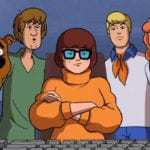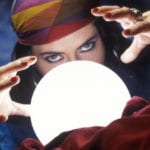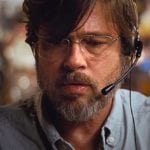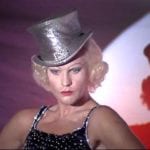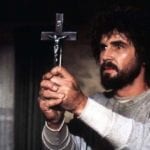 Weird Stuff
Weird Stuff  Weird Stuff
Weird Stuff  Animals
Animals 10 Inspiring Tales of Horses Being Human
 Mysteries
Mysteries Top 10 Haunting Facts About the Ghost Ship MV Alta
 History
History 10 Surprising Stories About the Texas Rangers
 Humans
Humans 10 Philosophers Who Were Driven Mad by Their Own Theories
 Miscellaneous
Miscellaneous 10 Video-Game-Worthy Weapons and Armors from History
 Weird Stuff
Weird Stuff 10 Psychics Who Accurately Predicted Wartime Events
 The Arts
The Arts 10 Pieces of Art Inspired by a Broken Heart
 Health
Health 10 Science Fiction-Sounding New Medical Treatments
 History
History 10 Surprising Facts About the Father of Submarine Warfare
 Weird Stuff
Weird Stuff 10 Times Real Laws Were Based on Bizarre Hypotheticals
 Animals
Animals 10 Inspiring Tales of Horses Being Human
 Mysteries
Mysteries Top 10 Haunting Facts About the Ghost Ship MV Alta
Who's Behind Listverse?

Jamie Frater
Head Editor
Jamie founded Listverse due to an insatiable desire to share fascinating, obscure, and bizarre facts. He has been a guest speaker on numerous national radio and television stations and is a five time published author.
More About Us History
History 10 Surprising Stories About the Texas Rangers
 Humans
Humans 10 Philosophers Who Were Driven Mad by Their Own Theories
 Miscellaneous
Miscellaneous 10 Video-Game-Worthy Weapons and Armors from History
 Weird Stuff
Weird Stuff 10 Psychics Who Accurately Predicted Wartime Events
 The Arts
The Arts 10 Pieces of Art Inspired by a Broken Heart
 Health
Health 10 Science Fiction-Sounding New Medical Treatments
 History
History 10 Surprising Facts About the Father of Submarine Warfare
Top 10 Films With Creepy Links To The Occult
A loose and highly sensational definition of the occult has been a part of cinema since its inception. For the most part, the horror film genre has been the occult’s unofficial home, with devil worshipers, pagan cults, and the like populating movies such as The Wicker Man, The Blood on Satan’s Claw, and others. Occult-themed movies really exploded in popularity during the 1960s and 1970s, when the hippie counterculture’s flirtation with Eastern thought and New Age practices was turned into something much darker. (The Manson family murders also helped to spread the idea that “peace and love” was just a front for hippie malevolence.)
While some of the entries here come from that time period, many are much older and date to the era of silent films. Some of these movies are linked to the occult by secondary and even tertiary threads. While some were written by writers looking to thrill audiences with blasphemous tales, others were penned by serious practitioners of the occult.
10Nosferatu
While sometimes erroneously called the first vampire film or the first adaptation of Bram Stoker’s Dracula (a lost Hungarian film from 1921 called Dracula’s Death may be the true first in both categories), Nosferatu is nevertheless a masterpiece. Directed by F.W. Murnau, Nosferatu is an Expressionist take on horror that tells its story in shadow and chiaroscuro. As an unauthorized adaptation of Dracula, Nosferatu essentially tells the same story of a Transylvanian vampire leaving his home and coming to Western Europe as a social plague. However, in Nosferatu, the fictional German city of Wisborg replaces London, while the time period is changed from the 1880s to the 1830s. Also, Nosferatu transforms Count Dracula’s figurative plague into a literal one that decimates an entire city. The characters in Nosferatu have slightly altered names such as Tomas Hutter instead of Jonathan Harker and Ellen Hutter instead of Mina Harker. Finally, unlike the suave aristocrat of Dracula, the vampire in Nosferatu, Count Orlok, is a rodent-faced demon that is much closer to folkloric depictions of the undead.
Because the film was made without the permission of Florence Stoker, Bram Stoker’s widow and the controller of his estate, the film was shelved until it slipped into the public domain decades later. This oversight almost killed any opportunity to not only see perhaps the world’s greatest vampire film, but also examine producer Albin Grau’s decision to imbue the film with occult symbolism. Grau, who has been described as a “lifelong occultist,” came upon the idea of making a vampire film after being exposed to Serbian vampire legends while serving in the Balkans during World War I. Later, while acting as the film’s producer and art designer, Grau decided to put occult-inspired hieroglyphics into the letters mailed between Count Orlok and the Renfield-like Knock. Overall, Grau and fellow producer Enrico Dieckman envisioned Nosferatu as a theosophic horror film that would incorporate Eastern mysticism into its overall tale.
9The Cabinet Of Dr. Caligari
Released years before Nosferatu, Robert Wiene’s The Cabinet of Dr. Caligari was the first horror film to explicitly incorporate elements of Expressionism into its mise-en-scene. A psychoanalytic exploration of madness and obsession, The Cabinet of Dr. Caligari concerns a young student named Francis (played by Friedrich Feher) who falls prey to the machinations of the evil circus performer and mesmerist Dr. Caligari (played by Werner Krauss). In particular, Dr. Caligari uses his sideshow attraction, a walking somnambulist named Cesare (played by Conrad Veidt), to harm those whom Francis loves the most. Ultimately, the whole experience turns Francis insane, at which point the audience realizes that the entire story has been an elaborate explanation for why the committed Francis detests his sanitarium’s director (who happens to look like Dr. Caligari).
Famously considered an allegory about Weimar Germany’s desire for a political strongman, The Cabinet of Dr. Caligari was intended to be a critique of authority. Specifically, screenwriter Carl Mayer (who, along with writing partner Hans Janowitz, had turned to pacifism after serving in World War I) was inspired to compose the story after dealing with a strange and abusive army psychologist. The genesis of Janowitz’s contribution to The Cabinet of Dr. Caligari stemmed from his firsthand experience of seeing a sex murder in Hamburg. As for the film’s connection to the occult, not only does The Cabinet of Dr. Caligari attempt to visually represent psychosis through contorted and uncanny stage sets, but it also deals with the possibility of cerebral suggestion, otherwise known as mind control.
8Genuine
Subtitled “Tale of a Vampire,” 1920’s Genuine was also directed by Robert Wiene. A little-known and very nonsensical film, Genuine is more or less a continuous dream sequence about one artist’s unhealthy obsession with a painting that features a goddess named Genuine. Like The Cabinet of Dr. Caligari, Genuine makes great use out of the painted sets produced by the Expressionist artist Cesar Klein. Narratively speaking, the priestess Genuine is depicted as fluent in Eastern magic and the ways of the occult.
A bizarre little film, Genuine was a flop during its day and has not received critical reappraisal since. That being said, Genuine offers a glimpse not only of the high degree of influence Freudian psychoanalysis had over German filmmaking during the early 1920s, but also at how seriously Weimar filmmakers studied occult practices. Wiene, along with directors Murnau and Paul Wegener, injected such things as theosophy, Kabbalah, and the aestheticism of occult practitioners such as Paul Klee, Max Ernst, and others into their early horror films.
7Haxan
Although filmed as a documentary, Danish director Benjamin Christensen’s 1922 film Haxan is widely considered one of the horror genre’s greatest and perhaps most disturbing films. Christensen was inspired to make a film examining witchcraft after studying the Malleus Maleficarum, the infamous 15th-century witch hunting guide written by two German Catholic monks. As a result, Haxan is full of shocking images that dramatize such things as Walpurgis Night celebrations and medieval black magic. Indeed, a major portion of the film’s first half is dedicated to dramatizing scenes of sacrilege and devil worship.
Despite its sensationalism, Haxan ultimately argues that the anti-witch hysteria of the Middle Ages and the Early Modern period was the result of misjudging mental illnesses and mass hallucinations as demonic possessions. When the film was released, its logical conclusions were ignored. Seen as a scathing critique of Catholicism, some 8,000 Catholic women took to the streets of Paris in order to protest its French premiere. In the United States, Haxan was banned outright.
6The Magician
Released in 1926, Rex Ingram’s The Magician, which stars the German actor and director Paul Wegener as the nefarious wizard Oliver Haddo, is one of the forgotten classics of the silent film era. Barring some alterations, Ingram’s screenplay is faithful to W. Somerset Maugham’s original novel. Published in 1908, Maugham wrote The Magician as a cynical attempt to earn a healthy payday. A potboiler about Haddo’s attempt to sacrifice the life of the beautiful Margaret in order to create grotesque homunculi, The Magician was inspired by one of Maugham’s acquaintances in Paris—the English occultist Aleister Crowley. In fact, Crowley thought The Magician bore such a close resemblance to his own work that he publicly accused Maugham of plagiarism.
In the film version, Wegener’s turn as Haddo is undeniably menacing. Bolstering this performance is Ingram’s experimental use of camera work. In particular, The Magician features a terrifying and innovative dream sequence that shows Haddo using black magic in order to create a hellish vision of a ritual dedicated to the Greek god Pan. Coincidentally, a widely reported story about Crowley claims that the occultist tried to summon Pan during a ritual that took place in Paris sometime during the early 20th century.
5Vampyr
Rather than Dracula, Carl Theodor Dreyer’s 1932 film Vampyr is a loose adaptation of another vampire classic—J. Sheridan Le Fanu’s novella Carmilla. Although released during the early days of sound, Vampyr is an almost silent film about the vampire-haunted village of Courtempierre. Allan Gray (played by the film’s financial backer Nicolas de Gunzburg), the film’s protagonist, is a serious student of the occult who begins to lose his grip on sanity once he enters Courtempierre. As a result, Vampyr mostly presents an untrustworthy narrative that drips with psychoanalysis, dream logic, and occult symbolism.
The action in Vampyr may take place in an alternative dimension wherein Gray has already died and is left only to observe the slow deterioration of Courtempierre’s residents. A more literal reading of film posits that Gray’s odd experiences are the result of a vampire’s curse on the village, which is only stopped once Gray and his love interest Gisele (played by Rena Mandel) drive an iron spike through the heart of the old crone Marguerite Chopin (played by Henriette Gerard). In a final act, the pair escape the village while the evil village doctor (played by Maurice Schutz) accidentally kills himself inside an abandoned mill.
According to Dreyer himself, his lifelong interest in the supernatural began when, as a little boy, he read certain books concerning the occult that he found in his grandmother’s library.
4Lucifer Rising
An experimental short film, Kenneth Anger’s Lucifer Rising was made as a sort of ode to San Francisco’s counterculture of the late 1960s. The film is also a psychedelic rumination on Anger’s search for a modern Lucifer, a bearer of light who will usher in a new age of freedom. Anger’s vision of Lucifer was largely inspired by the writings of Aleister Crowley, who believed that Lucifer would be the god of the coming age of Horus. Anger’s other great influence was Church of Satan founder Anton LaVey, who appears as the Devil in Anger’s other occult ode, Invocation of My Demon Brother. Also in Invocation of My Demon Brother, which was made from footage taken from the original cut of Lucifer Rising, is Bobby Beausoleil, the convicted murderer and Manson Family associate. Beausoleil also recorded a soundtrack for Lucifer Rising. Another Lucifer Rising soundtrack was recorded by Led Zeppelin guitarist and Aleister Crowley enthusiast Jimmy Page.
All told, Lucifer Rising, which stars British pop singer Marianne Faithful as the demon Lilith, represents Anger’s idiosyncratic take on the new religion of the counterculture.
3Simon, King Of The Witches
A surface reading of Bruce Kessler’s 1971 film Simon, King of the Witches would call it a campy take on the many Satan-themed horror films that were then incredibly popular. Featuring a story about a Los Angeles magician who tries to curse the “Establishment” through various Satanic rituals (most of which involve his magic mirror), Simon, King of the Witches does seem to have its tongue placed firmly in cheek. In one scene, Simon and his associate Turk (played by George Paulsin) conduct a drug-fueled ritual involving a goat and Ultra Violet (one of Andy Warhol’s muses and a later convert to Mormonism).
However, many authors have pointed out that Simon, King of the Witches displays familiarity with actual occult practices. While the character of Simon Sinestrari (played by Andrew Prine), a ceremonial mage who lives in a storm drain, presents a mockery of the counterculture archetype, his far-out adventures may actually be based on the real life practices of California occultist Poke Runyon.
2The Holy Mountain
Like many of his other creations, Alejandro Jodorowsky’s The Holy Mountain is a mind-bending exercise in surrealism. Its confusing narrative presents a mixture of Christian mysticism, occult symbolism, and psychedelic stream-of-consciousness. The film also presents a dramatization of the Tarot deck, with characters representing such cards as the Thief, the Hermit, and the Devil. The film’s most famous character, the Alchemist (played by Jodorowsky himself), spends most of the film performing various magic ceremonies, many of which are accompanied by naked women, Tarot characters, and goats.
The Holy Mountain is far from Jodorowsky’s only foray into the occult. His entire oeuvre often mixes occult symbolism with absurdity and depictions of altered consciousness. Because of this, he has sometimes been described as a Gnostic filmmaker. Along with his 1970 film El Topo, The Holy Mountain has also been accused of promoting the whims of the Illuminati by certain conspiracy theorists.
1Metropolis
Fritz Lang’s 1927 film Metropolis is a visual masterpiece about a futuristic city sharply divided by class. While the city’s wealthy live aboveground in skyscrapers that combine modern amenities with bucolic pleasure gardens, the workers live underground in cramped living quarters. Work in the city presents an extreme version of Taylorization, with everything from menial tasks to walking atomized and choreographed. After falling in love with a poor girl named Maria (played by Brigitte Helm), Freder (played by Gustav Frohlich), the rich son of Metropolis’s designer, decides to follow her down into the machine areas where the workers are employed in soul-crushing tasks. While posing as a worker, Freder experiences not only how dehumanizing the city’s labor can be (in a famous scene, Freder replaces an exhausted worker and takes manual control of a large clock), but he also witnesses a large-scale accident that kills and maims several workers. While witnessing this tragedy, Freder dreams that the factory transforms into a temple dedicated to the demon Moloch, a Phoenician, Canaanite, and/or Assyrian demon mentioned in the Old Testament in connection with the practice of child sacrifice.
Realizing that his son is starting to sympathize with the city’s subjugated workforce, Joh Fredersen (played by Alfred Abel) contacts the mad inventor Rotwang. Rotwang creates a female robot in the image of his lost love, Hel, in order to stir discontent among the workers. In the scene where Hel is brought to life, several pentagrams are visible in Rotwang’s laboratory. Apparently, Lang was interested in a deeper exploration of technology vs. magic, but cuts to Metropolis essentially canceled this narrative stream.
After effectively instigating a minor civil war among the workers, Hel is brought back above in order to perform a sensual dance for a party of Metropolis’s elite men. In this sequence, Hel is explicitly compared to the Whore of Babylon from Revelation. This is not the film’s only reference to the Bible. The story of the Tower of Babylon is recounted and juxtaposed with the landscape of Metropolis, which was designed to look like medieval depictions of the fabled structure. Those convinced that the film alludes to the Illuminati conspiracy often point to this symbolic reference as proof.
Without question, Lang and wife/co-creator Thea von Harbou (who wrote the novel Metropolis and its screenplay adaptation) were interested in occult matters. Von Harbou’s later support for National Socialism may have been partially inspired by her interest in Eastern mysticism and the occult.
Benjamin Welton is a freelance writer based in Boston. His work has appeared in The Weekly Standard, The Atlantic, Listverse, Metal Injection, and others. He currently blogs at literarytrebuchet.blogspot.com.

